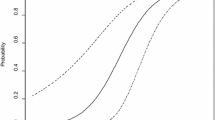Abstract
When the three-parameter logistic model is applied to tests covering a broad range of difficulty, there frequently is an increase in mean item discrimination and a decrease in variance of item difficulties and traits as the tests become more difficult. To examine the hypothesis that this unexpected scale shrinkage effect occurs because the items increase in complexity as they increase in difficulty, an approximate relationship is derived between the unidimensional model used in data analysis and a multidimensional model hypothesized to be generating the item responses. Scale shrinkage is successfully predicted for several sets of simulated data.
Similar content being viewed by others
References
CTB/McGraw-Hill. (1981).Comprehensive tests of basic skills, forms U & V. Monterey, CA: Author.
CTB/McGraw-Hill. (1982).Comprehensive tests of basic skills, forms U & V, test coordinator's handbook. Monterey, CA: Author.
CTB/McGraw-Hill. (1984).Comprehensive tests of basic skills, forms U & V, technical report. Monterey, CA: Author.
Doody-Bogan, E., & Yen, W. M. (1983, April).Detecting multidimensionality and examining its effects on vertical equating with the three-parameter logistic model. Paper presented at the meeting of the American Educational Research Association, Montreal.
International Mathematical and Statistical Libraries. (1979).IMSL Library (7th ed.). Houston, TX: Author.
Lord, F. M. (1975). The “ability” scale in item characteristic curve theory.Psychometrika, 40, 205–217.
Lord, F. M. (1980).Applications of item response theory to practical testing problems. New York: Lawrence Erlbaum.
Lord, F. M. (1984).Conjunctive and disjunctive item response functions. (Technical Report). Princeton, NJ: Educational Testing Service.
McKinley, R. L. (1983, April).A multidimensional extension of the two-parameter logistic latent trait model. Paper presented at the meeting of the National Council on Measurement in Education, Montreal.
Mislevy, R. J. (1984), Estimating latent distributions.Psychometrika, 49, 359–381.
Reckase, M. D. (1979). Unifactor latent trait models applied to multifactor tests: Results and implications.Journal of Educational Statistics, 4, 207–230.
Reckase, M. D., & McKinley, R. L. (1983, April).The definition of difficulty and discrimination for multidimensional item response theory models. Paper presented at the meeting of the American Educational Research Association, Montreal.
Wingersky, M. S., Barton, M. A., & Lord, F. M. (1982),LOGIST User's Guide. Princeton, NJ: Educational Testing Service.
Yen, W. M. (1983a). Tau equivalence and equipercentile equating.Psychometrika, 48, 353–369.
Yen, W. M. (1983b). Use of the three-parameter logistic model in the development of a standardized achievement test. In R. K. Hambleton (Ed.),Applications of Item Response Theory. British Columbia: Educational Research Institute of British Columbia.
Yen, W. M. (1984). Effects of local item dependence on the fit and equating performance of the three-parameter logistic model.Applied Psychological Measurement, 8, 125–145.
Author information
Authors and Affiliations
Additional information
The author is grateful to Robert Mislevy for kindly providing a copy of his computer program, RESOLVE.
Rights and permissions
About this article
Cite this article
Yen, W.M. Increasing item complexity: A possible cause of scale shrinkage for unidimensional item response theory. Psychometrika 50, 399–410 (1985). https://doi.org/10.1007/BF02296259
Received:
Revised:
Issue Date:
DOI: https://doi.org/10.1007/BF02296259




